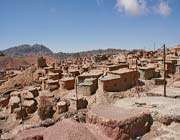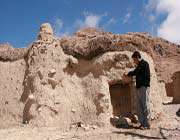Makhunik village

Makhunik village is 143 km away from the city of Birjand, in the Eastern part of the Iranian province of South Khorasan and is only 20 km from Iran-Afghanistan borderline. Due to its residents being relatively short, its intact condition and plain architectural style, the village has drawn the attention of tourists and social researchers. Researchers have discovered interesting points about its residents' unaffected way of living, customs, and traditions. There is no written historical evidence on this village except Coronel Charles Edward Pitt's travelogue of Khorasan and Sistan in which he has described Makhunik village in the era of the Qajar ruler, Naser-eddin Shah. According to some other evidence, however, it seems that the inhabitants of this village had been nomads and animal raisers in old days and became the locals of this region especially Makhunik village in some later periods. Another proof to the fact that Makhuik village has for a long time been residential is a stone inscription near Makhunik aqueduct in which the picture of an old shepherd has been cut.
Makhunik village has a fine moderate weather during spring and autumn, cold in winter, and hot and dry during summer. Its locals are Muslim and speak Farsi language with special Khorasani accent. Their major job is animal husbandry, but they do farming, too. The main agricultural products of Makhunik village are wheat, garlic, barley, turnip, beet, and a special type of carrot. Also to a less extent, these people plant tomato, onion and saffron. Garden products are not that much cultivated in the village. However, a number of jujube, berry, fig, pomegranate, apple, grapes, and almond trees have been planted next to the streams. Some of the inhabitants of this village work in the granite mines of the city of Birjand. Women make handicrafts the most important of which is carpet weaving. In addition to all these, some traditional jobs like spinning, cloth weaving, pottery, making brooms, socks, and the like can be noticed.
Among the souvenirs this village we can name jujube, garlic, straw hat, and local dried whey (that is a dairy product).
Makhuik village and its houses have a special architectural style. The village is on the steep slope and skirt of a mountain and has a very dense residential texture. Most of the houses are built one meter beneath the ground level, in one floor, with a flat roof and very low doors; such that entering them needs bending. Living room, bedroom, dining room, kitchen, and warehouse are all in the same space. Each house has spaces like Kandik (that is a place for storing wheat and barley), and Koreshk (that is an oven made of clay for cooking), and a ledge. These buildings are mainly made of stone, wood, and branches of trees, with their roofs mostly made of flat pieces of stone covered by a mixture of clay, grit, and mortar. All lanes of this village are on slope and none of them is on an even ground; this in turn has added to the architectural attractiveness of Makhunik village. Some measures have also been taken to build modern houses in the vicinity of the village for the villagers to reside in.

Among the historical attractions of Makhunik village, mention can be made of its very old houses, stone inscriptions, and the ancient tower. In line with traditional architecture, this ancient tower has been built of very simple materials and is known as Gol-Anjir tower.
Makhunik village is also famous for the customs and traditions observed in it. Everything in this village has its own rules; for instance land is traded in very small pieces because of the fact that the number of fertile lands is decreasing. Villagers of this region are very modest and contented; they eat very simple food usually made of the local farming products; and bake their needed bread at home. Regarding the low rainfall in the region, one of the common traditions observed among the regional people is an asking-for-rain ceremony which is held in a special way.
Source: irib.ir